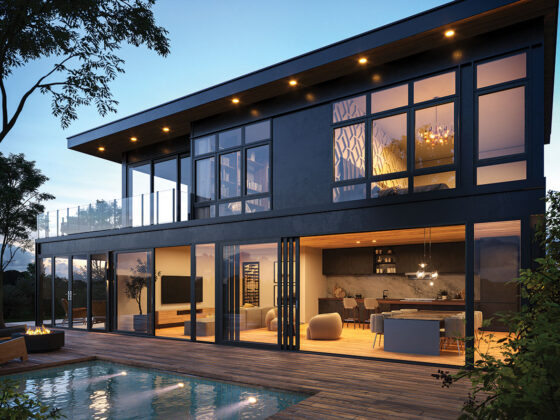
Local professionals offer advice for creating an outdoor living space.
Story by Tracy Dickinson
Featured in July 2020
Design trends are always fluctuating, affected by lifestyle changes, styles and fads, and even product and material innovations.
One factor that most haven’t considered is societal changes. In the 1940s every home had a victory garden, even if the homeowners had never pulled a weed before. In the 1970s improvements in materials and construction techniques led to finished lower levels and the popularity of the basement rec room.
In 2020 worldwide events are giving rise to numerous changes at home (see “Changing the Way We Live”). And as homeowners are seeking ways to make their homes better fit the way their lives are changing, they’re also looking for ways to enjoy summer in a time when so many summer activities are canceled.
We spoke to several local professionals who offer excellent advice on creating usable outdoor living space at home.

Design First
According to Devan Kaufman of Kaufman Construction, planning your outside space should be done with as much care as the interior of your home. “That’s a common theme with us at Kaufman Construction,” he says. “We try to make every project fit the homeowner’s lifestyle, not the neighbor’s or a magazine’s or ours. No project, no matter how impressive, is worth the money if you don’t use it.”
It’s important to ask yourself what you want from your outdoor space and how that desire fits with the way you live. Do you entertain often? Do you need to retain open space for kids to play? How much maintenance do you want to do?
In addition, says Kaufman, you should ask yourself what you want from a partnership. “Some homeowners want a partner that advises and designs and guides the project. Other homeowners have a clear vision of their project, and they want a partner who will simply implement that. Both are fine. It’s just important that everyone understands those expectations.”
It’s important to ask yourself what you want from your outdoor space and how that desire fits with the way you live. Do you entertain often? Do you need to retain open space for kids to play?
BLC Projects’ Rob Walker says, “Part of that conversation involves looking at the site, considering the sun at different times of day, looking at the options, and how best to work with existing structures and elevations.”
Keegan Lare of Ted Lare Design + Build agrees. “After the initial conversation with a client, the next step is checking out the site so we can ask specific questions and assess the elements we’ll be working with.”
“It’s important to get a sense of things, the exposure and how sun and wind will affect the site, what times of day the site will be used and how that changes the design needs,” Kaufman says. “In some neighborhoods, privacy might be a factor, too.”
“Every project has different challenges,” adds Harold Cross of Archadeck. “Homeowners want multifunctional spaces with unique features in each space. It’s a challenge to bring all those pieces together. Design is as important as the products and contractors you choose.”

Start with Foundational Elements
No matter what your vision, your outdoor plan should start with foundational elements and build from there. Do you want a deck or just a comfortable space to gather? Do you envision a mix of transitional and outdoor spaces? Will your project include a fire feature or water feature?
“Even a very simple outdoor space involves multiple interconnecting spaces. It’s important to treat them as one design. How do you transition from one to the next? Are some spaces covered and some uncovered? What is the grade on the site? How can you use that to your advantage in the design?” Kaufman explains.
Lare says, “That’s something we focus on—bringing a space together into one cohesive plan so every element fits the space and all of it fits the homeowner.” Although his company is known for landscaping expertise, it designs full outdoor living spaces and also partners with other companies to incorporate a landscaping plan with other structures.
Walker says that part of designing the foundational elements is getting the engineering right from the beginning. “We overengineer every project whether it’s a deck or other outdoor space,” he says. “Building codes are really the minimum standard. We want to be sure our work goes beyond that.”

Make It Yours
Once you have a plan in place and you know which elements will be included in your design, it’s time to start personalizing that design. What type of decking do you want? What about railing style? Will your plan include walkways? What type? Do you want to keep existing landscaping or incorporate new landscaping with your project?
“There are a lot of low-maintenance deck products available at every price point,” Cross says. “There’s a lot of technology going into the development of quality products.”
One of the products he’s been especially impressed, and has been using regularly, with is retractable screen systems. “You can create an entire screened-in porch area with wide-span windows, which offer a built-in, retractable screen that disappears into the frame. The windows have the benefits of a double-hung window with lower maintenance and unimpeded views,” he says.
Walker says that the wide range of colors and materials now available in decking opens up new possibilities for design as well. “Homeowners can choose different colors to create a border look or to incorporate a pattern in the floor design. It doesn’t add significantly to the cost. It just needs to be planned ahead of time so the right materials are available.”
And Kaufman says the deck design doesn’t have to be limited to wood or wood-look materials. “We’ve done decks with stone pavers in them,” a technique that brings even more natural products into the design, he says.
Cross says some of his favorite projects have included outdoor kitchens. “You have to be creative about designing a kitchen, making sure you can achieve what homeowners want while still making it fit the space and be functional whether it’s just a grill and counter area or includes everything plus the kitchen sink.”
Lare says fire pits can be customized to the homeowner. “You can get gas or wood-burning fire pits. And the design can be adapted to the homeowner’s preference whether it’s for aesthetic reasons or it’s to provide heat and be usable longer into the fall and earlier in the spring.”
Whether you’re just looking to create a little space to relax or you’re envisioning an oasis to escape the chaos, when you start with a good plan and the right design partner, you’ll be living large right in your own backyard. •
Resources
- Harold Cross Archadeck
- Rob Walker BLC Projects
- Devan Kaufman Kaufman Construction
- Keegan Lare Ted Lare Design + Build








